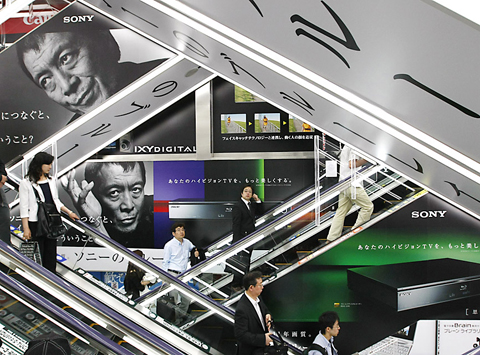Sony Corp reported a ¥98.9 billion (US$1 billion) loss for the fiscal year ended March — its first annual net loss in 14 years — and projected more losses this year amid a serious slump in the global electronics market.
Sony also said yesterday it was closing three plants in Japan to help turn its business around.
Hit by dropping sales and a strong yen, Sony lost ¥165 billion in the January-to-March quarter, compared with a ¥29 billion profit for the same period the previous year.

PHOTO: REUTERS
The Japanese electronics and entertainment company said no quick recovery was in sight, projecting a ¥120 billion (US$1.2 billion) loss for the fiscal year through March 2010.
The results are a reversal from the ¥369.4 billion profit Sony recorded a year earlier. Sales for the fiscal year through March slid 12.9 percent to ¥7.73 trillion, it said.
Sony, which makes Bravia flat-panel TVs and Cyber-shot digital cameras, is closing three plants in Japan by the end of December — one for handsets, another for video recorder parts and another for systems used for smart cards. After they are shuttered, the number of Sony’s global plants will dwindle from 57 last year to 49.
By operations, Sony said it had an operating loss in its core electronics segment because of the slowing global economy, price competition and a strong yen, which offset profits from its liquid-crystal display TV division.
Sony also continued to lose money in its game segment, where its PlayStation 3 home console and PlayStation Portable have struggled against rival offerings from Nintendo Co, the Wii and DS, as well as in some markets against the Xbox 360 from Microsoft Corp.
The company sold 10.06 million PlayStation 3 machines for the fiscal year through March, up 10 percent from the previous year. It also sold more PlayStation Portable machines, at 14.1 million during the fiscal year, up slightly from 13.8 million.
In its movies division, home entertainment sales declined despite stronger motion picture releases, including Hancock, Sony said.
Analysts say Sony chief executive Howard Stringer, who decided to centralize power earlier this year, has yet to give details of a turnaround plan, including strategies and products.
Stringer has promoted four relatively young executives into his managerial team, representing Sony’s gaming and electronics sectors.
Sony also faces a host of rivals that make similar products, often at cheaper prices, such as Samsung Electronics Co of South Korea, as well as manufacturers from Taiwan, China and other nations, such as Acer Inc (宏碁) and Lenovo Group Inc (聯想).

Authorities have detained three former Taiwan Semiconductor Manufacturing Co (TMSC, 台積電) employees on suspicion of compromising classified technology used in making 2-nanometer chips, the Taiwan High Prosecutors’ Office said yesterday. Prosecutors are holding a former TSMC engineer surnamed Chen (陳) and two recently sacked TSMC engineers, including one person surnamed Wu (吳) in detention with restricted communication, following an investigation launched on July 25, a statement said. The announcement came a day after Nikkei Asia reported on the technology theft in an exclusive story, saying TSMC had fired two workers for contravening data rules on advanced chipmaking technology. Two-nanometer wafers are the most

NEW GEAR: On top of the new Tien Kung IV air defense missiles, the military is expected to place orders for a new combat vehicle next year for delivery in 2028 Mass production of Tien Kung IV (Sky Bow IV) missiles is expected to start next year, with plans to order 122 pods, the Ministry of National Defense’s (MND) latest list of regulated military material showed. The document said that the armed forces would obtain 46 pods of the air defense missiles next year and 76 pods the year after that. The Tien Kung IV is designed to intercept cruise missiles and ballistic missiles to an altitude of 70km, compared with the 60km maximum altitude achieved by the Missile Segment Enhancement variant of PAC-3 systems. A defense source said yesterday that the number of

A bipartisan group of US representatives have introduced a draft US-Taiwan Defense Innovation Partnership bill, aimed at accelerating defense technology collaboration between Taiwan and the US in response to ongoing aggression by the Chinese Communist Party (CCP). The bill was introduced by US representatives Zach Nunn and Jill Tokuda, with US House Select Committee on the Chinese Communist Party Chairman John Moolenaar and US Representative Ashley Hinson joining as original cosponsors, a news release issued by Tokuda’s office on Thursday said. The draft bill “directs the US Department of Defense to work directly with Taiwan’s Ministry of National Defense through their respective

Tsunami waves were possible in three areas of Kamchatka in Russia’s Far East, the Russian Ministry for Emergency Services said yesterday after a magnitude 7.0 earthquake hit the nearby Kuril Islands. “The expected wave heights are low, but you must still move away from the shore,” the ministry said on the Telegram messaging app, after the latest seismic activity in the area. However, the Pacific Tsunami Warning System in Hawaii said there was no tsunami warning after the quake. The Russian tsunami alert was later canceled. Overnight, the Krasheninnikov volcano in Kamchatka erupted for the first time in 600 years, Russia’s RIA